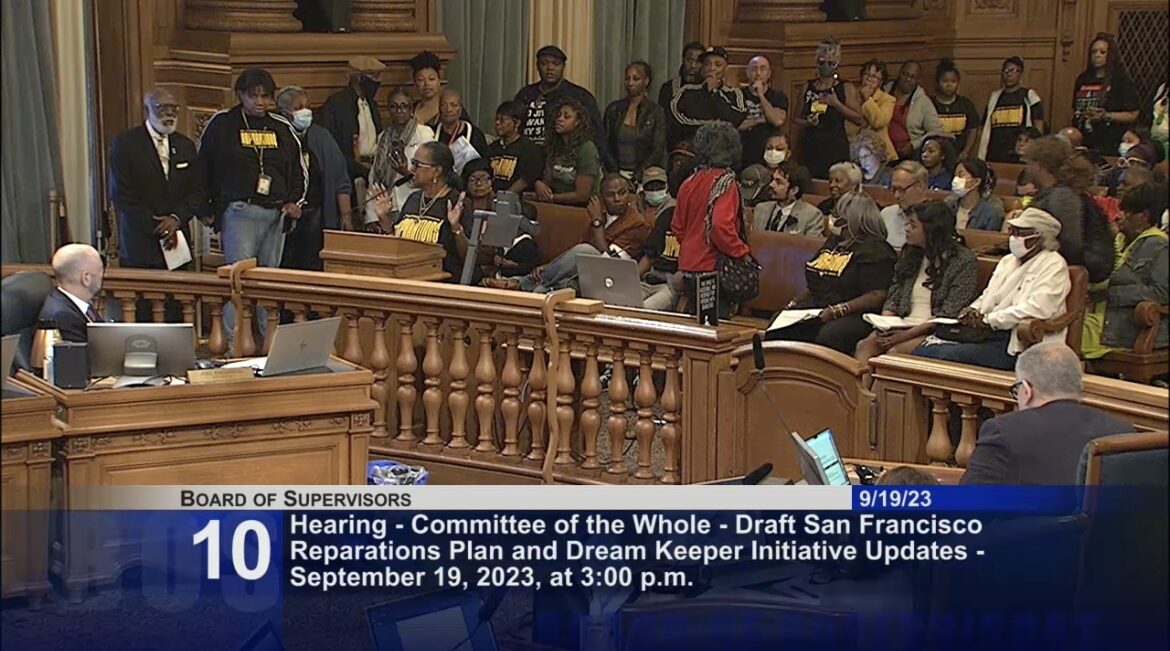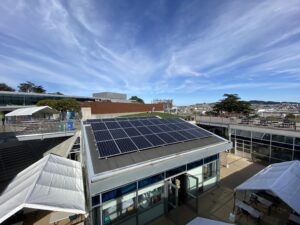After almost three years of drafting, meeting with experts and listening to San Francisco’s Black residents, the African American Reparations Advisory Committee (AARAC) awaits the final decision on their proposed reparations plan in January 2024. If approved, Black San Franciscans may begin to have the chance to repair historical harms caused by chattel slavery, redlining, education inequality and more.
The resolution for the creation of a reparations task force was first introduced in February 2020 by District 10 Supervisor and Board of Supervisors president Shamann Walton. Eight months later, the proposal was approved by the Board of Supervisors and the AARAC was formed.
Even though the fight for reparations is nothing new in both San Francisco and national history, it was reignited with the death of George Floyd in 2020 and the resulting worldwide Black Lives Matter protests. Although the promise of 40 acres and a mule may no longer be relevant to the lives of Black Americans, many still feel that they deserve compensation for the traumas that their ancestors endured and the ways that they have been systematically disadvantaged.
The complete proposal drafted by the AARAC and released in July 2023 comprises over 100 suggestions that the city can implement for its Black residents; many address financial recompense including $5 million one-time payments, house prices down to $1 and $97,000 guaranteed annual salaries for 250 years. Others address social and educational inequities for Black San Franciscans that include an Afrocentric curriculum for grades K-12, supplying cards that provide lower rates of admission for certain institutions and job prioritization.
The committee comprises 15 seats that aim to represent a different aspect of the Black experience in San Francisco including housing displacement, incarceration and workplace discrimination. Among these 15 members, they are further split into four smaller subcategories —Education, Health, Economic and Policy — to address specific concerns of the committee and Black San Franciscans as a whole.

photo courtesy of SF Board of Supervisors Meeting Archive
As an educator in the San Francisco Unified School District (SFUSD) for 23 years and AARAC member, Laticia Erving is no stranger to the disparate education experienced by Black youth in San Francisco and the impacts that it has upon their lives. “It negatively impacts generational wealth, social mobility and in many cases leads to the perils we see in our communities such as crime, drug abuse, mass incarceration, broken homes and more” she said. The harms that she witnessed and experienced firsthand as an educator and mother inspired her to fill the Committee seat open to parents of SFUSD students facing educational barriers.
“I wanted to make sure that the voices of parents and families were uplifted in this [reparations] process, and to make sure that we reform our educational system, that it’s an equitable system for all Black children,” Erving said.
Along with the input of parents, the AARAC wanted to ensure that the Black community of San Francisco felt heard while they were drafting their recommendations. In collaboration with the Human Rights Commission, they hosted community events at local churches as well as informational sessions with collegiate researchers. Additionally, they conducted focused outreach efforts on densely populated Black communities such as the Western Addition, Ingleside and Bayview neighborhoods. Due to the widespread impact that their proposal will have upon Black San Franciscans, actively engaging a wide range of community members was integral to their drafting process.
Despite their deliberate community engagement efforts, the AARAC has faced pushback from both Black and non-Black communities concerning the terms of the proposal. Much of the controversy, both locally and nationally, has centered on the $5 million one-time payment, the largest sum ever proposed for reparations.
In comparison, the California Reparations Task Force proposes a sliding scale capped at $1.2 million for older Black California residents. However, registered California voters remain divided on the issue of cash reparations with 58% in opposition and only 28% in support according to data released by University of California Berkeley’s Institute of Governmental Studies.
This specific term of the proposal has amassed considerable national attention as the masses worry about the impact that it will have on the city’s budget and already existing debt. If accepted, the $5 million payments would cost San Francisco $100 billion which is over seven times the annual budget of $14 billion.
“I don’t want to focus on the cash payment or the amount of money too much because I think that detracts from the more in-depth conversation that needs to be had [about reparations]. But I think it’s hard to say, ‘yes, you should implement it’ when the city budget is too small to be able to,” said Lakshmi Sarah, a KQED reporter. She has been covering the California Reparations Task force since June 2021.
Within the city’s Black community, there have also been criticisms concerning this mass sum and the impact that it could have upon the approval of the proposal’s other terms. Some residents would rather forfeit the $5 million in order to increase the likelihood of receiving the other suggestions, whereas others are only interested in receiving financial reparations.
“We’re not a monolith, we have different voices and opinions about how to redress harm. In my opinion, we need it all,” said Erving.
According to a PBS article by Janie Har, critics claim that taxpayers should not have to pay reparations given the city’s lack of participation in chattel slavery, which reparations efforts commonly redress. They believe that it is unfair to shoulder the economic weight that the proposal will carry for discriminatory policies enacted by their government which they had no control over. However, these opinions do not acknowledge the other ways that Black residents have suffered because of the city government, namely through the lens of redlining and housing displacement.
Targeted redevelopment projects throughout the 1960s and 1970s aimed at Black communities in thriving neighborhoods like the Fillmore, known as the West Coast’s Harlem at the time, have caused an uneven balance of housing access in the present.
According to a report drafted by the Stanford Law School and the Martin Daniel Gould Center, it is estimated that 20,000 to 30,000 residents were thrown out of the Fillmore neighborhood due to urban renewal projects by the city. These properties are now estimated to be valued at between $830,000 and $2.2 million, making them inaccessible to many of their previous tenants.
Films like The Last Black Man in San Francisco have recently brought attention to this issue. Released in 2019, the movie focuses on the character Jimmie Fails who dreams of reclaiming his grandfather’s Victorian house in the Fillmore neighborhood that they lost in Fails’ childhood. Throughout the film, he remains steadfast to its preservation, often returning to upkeep it from neighbors who he believes do not care about it enough. But ultimately, he gives up on ever repossessing the house and moves away from the city and the pain associated with this lost property.
Although fictional, his story mirrors many other Black San Franciscans who left the city after redevelopment tore down their neighborhoods. One estimate from the above report claims that 15% of those evacuated left San Francisco altogether which is consistent with the shrinking Black population currently in the city. As of 2022, Black residents made up 5.7% of the San Francisco demographic which is a stark decrease since the previous statistic of 13.4% during 1970, the golden age of the Fillmore.
In the present, countless Black people have been forced to leave the city after their families lost their homes like Fails’. Until now, there has been no great recognition of this harm by the San Francisco government which makes the approval of the reparations proposal even more imperative.
“We have to own up to that [harm] as a city. The city has to take responsibility for the things that they have done to steal wealth, and to steal opportunities from its Black citizens,” said Erving.
While the city awaits the Board of Supervisors, Human Rights Commission and Mayor London Breed’s decisions on the proposed reparations plan, San Francisco residents find themselves wondering whether it will be approved.
Thelonious Johnson, English teacher at Lick-Wilmerding High School, doubts that Black San Franciscans will receive reparations in the near future given the pushback that the AARAC’s proposal has faced by the public. Furthermore, he questions whether reparations will ever be possible in this city. “What I fear the cynic in me feels that there’s [statements of] ‘let’s talk about this, let’s talk about this, let’s talk about this’ without ever actually happening. I have serious doubts about [the proposal] being passed in San Francisco even though [the movement] seems to be moving forward.”
According to a survey conducted by Pew Research Center, Johnson’s opinions on the likelihood of reparations are consistent with those of many other U.S. Black adults. 82% of Black-identifying people surveyed believed that it was unlikely reparations would be given during their lifetime.
However, the AARAC assures residents that their plan for reparations is not a one-time solution to disparate conditions for the city’s Black community and are committed to seeing recompense happen for their fellow citizens. Even in the face of national pushback, they are dedicated to spending additional years to alleviate the conditions experienced by Black San Franciscans.
“As long as it took to create the problem, we’re probably going to have to work twice as hard to correct it,” said Erving.
According to Erving, past just the specific terms of the proposal, there are countless other initiatives that must happen in order to address the condition of Black San Franciscans. “We’re gonna have to reform all of our public systems. We’ll have to reform our Department of Public Health. We’ll have to repair our education system, we’ll have to think about the businesses and the accessibility of opportunities,” she said. “[Reparations aren’t] a magic bullet, it’s gonna take every last one of us to be engaged.”







1xbet промокод на бесплатную ставку 2024 1xbet промокод на бесплатную ставку 2024
Le code promotionnel 1XBET En utilisant le code bonus 1XBET 2023 vous activerez l’offre de bienvenue VIP pour les paris ou les jeux. Code promo 1x pari Recevez un bonus exclusif de 100 % jusqu’à 130 € de paris ou un package de bienvenue de 1950 € + 150 tours gratuits. 1Code promotionnel XBET 2023
Si vous recherchez de l’excitation et des opportunités uniques dans le monde des paris en ligne, vous ne pouvez pas manquer de profiter du code promotionnel 1xbet. bonus 1xbet Avec le code promotionnel 1xbet, vous accéderez à des offres et bonus exclusifs qui élèveront votre expérience de jeu à un autre niveau. Que vous préfériez les paris sportifs ou les jeux de casino, le code promotionnel 1xbet vous fera bénéficier d’avantages supplémentaires pour maximiser vos chances de gagner. Ne manquez pas cette opportunité extraordinaire de profiter pleinement de vos paris en ligne avec le code promotionnel 1xbet. Inscrivez-vous aujourd’hui et découvrez pourquoi nous sommes leader dans le monde des paris en ligne grâce à notre code promotionnel exclusif !